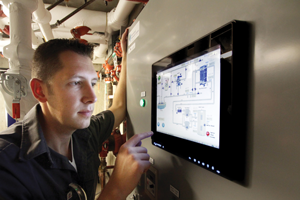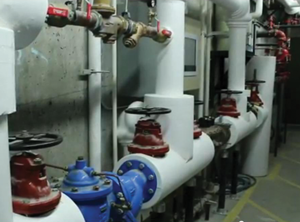Tapping into Wastewater Heat
Anyone who plans, builds or operates water distribution systems attachs great importance to efficiency as well as the reliability of system components.
#water-wastewater #components #automation
As a result of this efficiency and dependability, hot and cold water is easily accessible in almost every American household and commercial building today. But after the dishes are washed, the clothes are cleaned and our hands or bodies are clean, the leftover warm (and sometimes hot) water flows equally efficiently right out of our homes and buildings and into our sewers.
What isn’t so efficient about the system is that valuable heat energy exits along with the used water.
According to the U.S. Department of Energy, U.S. households flush 350 billion kilowatt hours of energy down the drain every year. Considering that Americans pay an average of 12 cents per kilowatt hour, this equates to $42 billion dollars in wasted heat energy per year. This wasted heat also accounts for roughly 9% of U.S. residential carbon dioxide emissions.
For these reasons, it may be time to rethink the vision of what it means to plan, build and operate efficient wastewater systems to include sewage heat recovery (SHR).
RECOVERING ENERGY
These types of operations have already been used in Norway, Japan and China. In North America, forward-thinking cities such as Vancouver, Seattle and Philadelphia have also begun implementing SHR.
The simple fact is that water enters our buildings at 40-50°F (4-10°C) and leaves at 66-77°F (18-25°C). If this heat can be captured, it can be used to fulfill 40-50% of our buildings’ energy requirements.
The technology is not complicated. First, a filter is used to separate out solids, which make up about 2-3% of sewage. Then, with the help of a heat pump and heat exchanger, the heat from the sewer water is transferred to clean water, and this warm, clean water is sent back into the building.
At the end of this cycle, the clear sewer water picks up the solids that were extracted at the start and flushes them back into the municipal sewer system.
In the summer, buildings with SHR systems can reverse their heat pumps and use the waste water to reduce a building’s air-conditioning costs. In this scenario, the heat pumps extract heat from the building and transfer it through the exchanger into the sewer water.
VALVES USED
Generally, SHR systems use manual butterfly valves. Typically these valves are 4-6 inches but some are larger depending on the size of the piping, which is dictated by flow rates. These butterfly valves are designed for pressures ranging from vacuum to 300 psi/2065 kPa.
An automatic reverse flush addition uses a number of automatic butterfly valves to control the reverse flush. This system can use as little as two, 3-way valves or four, 2-way valves, but for larger systems with multiple heat exchangers, there may be dozens of valves.
Actuators are electronic for these systems. At any given time, if a system senses blockage in the heat exchanger or if the pressure sensor shows elevated levels, the system will reverse flush out and then go back to normal. This can also happen automatically every three to four months, as specified by computer monitoring systems.
The heat pump-based water heaters use the same operating principles as an air conditioner or a domestic refrigerator. The pump gathers heat from the warm water source, and through the refrigeration cycle, deposits the heat into clean water at a useable temperature.
Moving heat with a heat pump is best for conservation purposes because the heat is not generated by burning fossil fuel (i.e., natural gas) or by electric resistance. Water can be heated using one third to one fourth of the energy required by electric resistance or gas, depending on the temperature of the heat source supplied to the heat pump.
These systems can be highly efficient, operating at energy savings of 76% and operating at efficiencies of 500-600%, meaning that for every dollar spent on operations, $5 worth of heat could be recovered.
INFRASTRUCTURE POSSIBILITIES
Meanwhile, progressive cities worldwide are exploring the concept of district-wide energy systems, including SHR, which can easily plug into this level of infrastructure. District energy systems are large-scale, multi-building heating projects that can supply energy over a large area using either recovered energy from other buildings, industrial sources, waste or by burning carbon-neutral fuels.
The beauty of SHR systems is they don’t require a quantum shift in everyday lives or operations. Humans will continue to take showers, wash their hands, do the laundry, flush the toilet. They might even leave the hot water tap on by mistake while running to grab a phone. Sewage heat recovery simply captures this wasted heat and reprocesses the energy to maximize benefits.
At the 32nd Annual Valve Industry Leadership Forum in January of 2014, Scott Graham from the global investment banking firm Jefferies noted that the water and wastewater sector accounts for 18% of the world valve market, and he predicted steady growth in this sector over the next 20 years.
That means innovative solutions such as SHR could contribute significantly to future demand for valves in the water and wastewater industry.
Lynn Mueller, an advocate of sustainable space conditioning energy systems for 25 years, recently started International Wastewater Systems (www.sewageheatrecovery.com). Formerly, he was president of Earth Source Energy Inc. and president of WaterFurnace Canada. Reach him at lynn@sewageheatrecovery.com.
RELATED CONTENT
-
The Pulp and Paper Industry
The pulp & paper industry has seen tough times, but the business will still be around for many decades; the product is too much in demand.
-
Dealing with Sand Erosion in Control and Choke Valves
Sand erosion in control and choke valves is a significant consideration offshore.
-
Proper Care of Knife Gate and Slurry Valves
How to resolve—and avoid—field failures of knife gate and slurry valves










 Unloading large gate valve.jpg;maxWidth=214)


